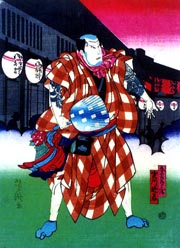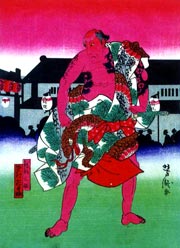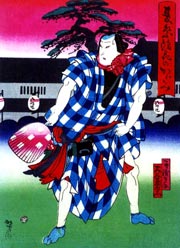| NATSU MATSURI |
| Play title | Natsu Matsuri Naniwa Kagami Summer Festival: Mirror of ďsaka |
|||||||||||||||||||||
| Authors | Namiki Senryű I Miyoshi Sh˘raku Takeda Koizumo I (Takeda Izumo II) |
|||||||||||||||||||||
| History |
The play "Natsu Matsuri Naniwa Kagami" was originally written for the puppet theater (Bunraku) and staged for the first time in the 7th lunar month of 1745 in ďsaka at the Takemotoza. It was so successful that it was almost immediately adapted for Kabuki and staged for the first time in the 8th lunar month of 1745 in Ky˘to at Miyako Mandayű's theater. It was produced by the zamoto Nakamura Kiyosabur˘ I and starred Fujioka Daikichi and Sakakiyama Danshir˘ I in the roles of Danshichi Kurobŕ and Tsuribune Sabu. It was a long run and the performance was extended up to October. According to the chronicles, the play was simultaneously staged in another Ky˘to theater in the 8th lunar month of 1745, at the Minamigawa no Shibai, produced by Nakamura Kumetar˘ I. A few months later, this ďsaka play was finally staged in ďsaka. The three main Kabuki venues decided to produce it almost simultaneously, starting a fierce competition for the best performance and line-up. It was first staged at the ďnishi no Shibai from the 5th of the 12th lunar month of 1745, produced by Arashi San'emon IV and starring Nakayama Shinkur˘ I in the role of Danshichi [casting]. Then it was staged at the Naka no Shibai from the 10th of the 12th lunar month of 1745, produced by Ichiyama Sukegor˘ I and starring Arashi Shichigor˘ I in the role of Danshichi [casting]. It was finally staged at the Kado no Shibai from the 15th of the 12th lunar month of 1745, produced by Arashi Sanjűr˘ II and starring him in the role of Danshichi [casting]. "Natsu Matsuri Naniwa Kagami" was staged for the first time in Edo in the 5th lunar month of 1747, at the Moritaza (casting unknown). |
|||||||||||||||||||||
| Structure |
"Natsu Matsuri Naniwa Kagami" is a 9-act drama. A standard production of "Natsu Matsuri Naniwa Kagami" is made up of act III ("Sumiyoshi Torii Mae"), act VI ("Tsuribune Sabu Uchi") and act VII ("Nagamachi Ura"). Acts I, IV or VIII are occasionally staged. Acts II, V and IX are long-forgotten. |
|||||||||||||||||||||
|
||||||||||||||||||||||
| Key words |
Danshichi Danshichimono D˘guya Doro Doroba Dorobune Gidayű Ky˘gen Hondoro K˘ro Koroshiba Koroshi no Mie K˘zugű Michiyuki Naniwa Sewamono Sumiyoshi Taisha |
|||||||||||||||||||||
| Summary |
Act I: Sakai Otai Jaya Tamashima Isonoj˘, the wayward son of Tamashima Hy˘dayű, has fallen in love with a courtesan named Kotoura, and spends his days and nights at a teahouse where she works. Okaji, a female messenger from Isonoj˘'s mother interrupts the drunken spree, urging him to return to the family house. He refuses, since this will allow fellow clansman ďtori Sagaemon, who also loves Kotoura, to whisk her away. Okaji has a personal interest in getting Isonoj˘ to return: her husband, Danshichi Kurobŕ, has been jailed. He was involved in a drunkard brawl with one of ďtori Sagaemon's henchmen. The retainer was severely wounded and Danshichi was arrested. Tamashima Hy˘dayű has promised Okaji to secure a pardon for her husband if she can persuade Isonoj˘ to go back home. To success in her mission, Okaji has arranged for a skit to be performed before Isonoj˘'s eyes. Three beggars "unexpectedly" tumble into the teahouse's garden. Two of them are beating up the third one, a man named Tokubŕ, who is accused of being a thief. Stealing others beggars is a serious crime in the beggars' world as it means that the code of honor of the brotherhood has been broken. Tokubŕ claims to be the son of a wealthy merchant who was disowned by his family for wasting his days away at the brothers. He has fallen so low in this world as to become a beggar. He blames himself for this sad situation and is ready to be submitted to whatever punishment his companions want to inflict on him. Okaji's secret plot works well. Isonoj˘ is moved to leave the Otai teahouse. However, he unfortunately runs into ďtori Sagaemon, who gleefully tells him that he has been disowned on suspicion of stealing a family heirloom (a sacred sword) to finance his debauchery in the pleasure quarters of ďsaka. Act III: Sumiyoshi Torii Mae Danshichi Kurobŕ, an otokodate in the city of Sakai who works as a fishmonger, is about to be released from jail in front of the torii of the Sumiyoshi shrine. He was imprisoned for he wounded a henchman of the samurai ďtori Sagaemon during a street fight. Danshichi's wife Okaji, their son Ichimatsu and Tsuribune Sabu, another otokodate and close friend of Danshichi, came at the Sumiyoshi Shrine to welcome him. After discussing with Sabu, Okaji and Ichimatsu enter the shrine to pray. A palanquin arrives, bearing a young, refined and penniless samurai named Tamashima Isonoj˘. He has a strong argument with the palanquin-bearers who refuse to go any further if he does not immediately pay them a huge amount of money. Isonoj˘, who is too weak to defend himself, is rescued by Sabu. The old man, who knows the right price for the palanquin ride, throws his own money to the 2 palanquin-bearers and orders them to leave the place on the spot. Isonoj˘ thanks Sabu for his help and the two men starts to discuss. Isonoj˘ tells that he plans to go to Nagamachi in ďsaka, to the house of Mikawaya Giheiji to meet Danshichi's wife Okaji. Sabu immediately understands who the young man is. Isonoj˘'s father, Tamashima Hy˘dayű, is the former master of Danshichi and Okaji and, thanks to his help and support, Danshichi, who should have been condemned to death, received only a prison sentence. Sabu tells Isonoj˘ to go to a restaurant called Kobuya, the place where everybody will soon gather to celebrate the release of Danshichi. Isonoj˘ leaves the place and Sabu decides to go to a nearby barbershop. Danshichi, surrounded by policemen, bearded and wearing prison clothes, arrives at the gate of the shrine. The leader of the group reads the report of Danshichi's arrest and sentence. Then, he orders his men to release the prisoner. Danshichi is so grateful to Tamashima Hy˘dayű that he publicly swears to always protect his son Isonoj˘. Sabu comes out of the barbershop and greets his friend. He also gives him some new clothes and quickly goes to the Kobuya. Danshichi enters the barbershop to get rid of his prisoner beard. A running young woman suddenly appears on stage. She is the courtesan Kotoura, the lover of Isonoj˘, and she is pursued by ďtori Sagaemon, the samurai whose one of his retainers died after a fight against Danshichi. Kotoura, who was released from her house of assignation by Isonoj˘, is ardently lusted after by Sagaemon. He tells her that Hy˘dayű has disinherited his son and that she should go with somebody who could afford to support her like himself. The girl tries to escape the lustful samurai ... who is suddenly grabbed by a strong hand reaching out from within the barbershop. This hand is Danshichi's one, who appears back on stage, beardless and wearing his new clothes. He enjoys himself twisting Sagaemon's body to show Kotoura the way to the Kobuya restaurant, where she will meet the others. Kotoura immediately leaves the place and Sagaemon flies away without a murmur. The two palanquin-bearers, who hassled Isonoj˘ earlier, are back at the gate of the shrine with another otokodate named Issun Tokubŕ. All of them are paid by Sagaemon to avenge him for the humiliations subjected by Danshichi and retrieve Kotoura. Danshichi can easily drive the two palanquin-bearers away but Tokubŕ is another kettle of fish. Their fight is suddenly interrupted by Danshichi's wife Okaji, who rushes between them and suceeds in pulling them apart. She is very angry and says to her husband that he should be ashamed for quarrelling and fighting. Then, she recognizes Tokubŕ, whom she met in the first act of this play ("the Otai Teahouse in Sakai"). Tokubŕ, who is a native of the Tamashima village, has a debt to Tamashima Hy˘dayű. Therefore, he can't side with Sagaemon, the enemy of his benefactor's son. He immediately takes the decision to join Danshichi to protect Isonoj˘ and Kotoura. The two men vow to become brothers in spirit and, as a testimony, both of them rip one sleeve from their kimono and exchange it. The act ends with the return of the two palanquin-bearers who are one more time put off the scent by both Danshichi and Tokubŕ. Act IV: Uchihonmachi D˘guya With the help of Danshichi, Isonoj˘ is now posing as a clerk at a curio shop (d˘guya) run by a man named Magoemon in Uchihonmachi in ďsaka. Meanwhile, the curio shop's daughter Onaka has fallen in love with Isonoj˘, which does not displease Isonoj˘, but is a matter of consternation for the chief clerk Denpachi, who wants Onaka for himself. Danshichi comes to the curio shop selling fish, and he and Onaka go inside. Isonoj˘ is now left to run the shop, and it is here that the tragedy begins. Danshichi's father-in-law Giheiji has conspired with Denpachi and a no-good curio dealer named Yaichi to swindle money out of Isonoj˘. Yaichi has consigned to the shop an antique incense burner (k˘ro) to sell for him on commission. Giheiji comes disguised as a samurai, and agrees to buy it for 55 ry˘. When he and Denpachi go inside, Yaichi appears and says that he is willing to sell the incense burner for 50 ry˘. Thinking that he will be saving the shop 5 ry˘, Isonoj˘ borrows the money from Denpachi and pays Yaichi, who then leaves. Now Giheiji reappears. Not only does Giheiji deny having agreed to buy the incense burner for 55 ry˘, but Denpachi demands immediate repayment of his loan of 50 ry˘. When Isonoj˘ protests, they attack him. Danshichi rushes in, only to find that the swindler is his own father-in-law. When Magoemon appears, he declares the incense burner to be of no value. Giheiji leaves, and Danshichi promises that he will pay back the money Isonoj˘ owes. He and Isonoj˘ then leave the shop. That night, Isonoj˘ returns with the intent of killing Denpachi in revenge. Onaka tells him that Magoemon has taken pity on him and given him the 50 ry˘ necessary for him to repay his loan. Denpachi approaches, and Isonoj˘ hides in a watch- man's hut while Denpachi attempts to persuade Onaka to run off with him. He forces her into the watchman's hut so she will not escape while he goes to steal money from Magoemon. Yaichi comes for his share of the spoils, and Denpachi tells him to watch over the hut. When Yaichi enters the hut with the intention of running off with Onaka, Isonoj˘ stabs him to death. Denpachi returns, but in the dark, he cannot recognize Isonoj˘, and gives him Yaichi's money, which Isonoj˘ takes and then runs off with Onaka. Act V: Michiyuki Imose no Hashirigaki Isonoj˘ and Onaka have come to the forest of Yasui. Isonoj˘ writes a will saying that he intends to kill himself for the murder of Yaichi. But Sabu appears and talks them out of their plan, persuading them to go into hiding temporarily instead. Now Denpachi appears, searching for Onaka. She lies, saying that she plans to commit suicide, and the fickle Denpachi, more interested in the money she car- lies than in his love for her, volunteers to show her how to hang herself As he is doing so, Sabu pulls his legs and strangles Denpachi to death. Isonoj˘'s will is unsigned, so Sabu puts it on Denpachi's body to make people think that Denpachi murdered Yaichi and killed himself in atonement. Act VI: Tsuribune Sabu Uchi This is the eve of the K˘zu shrine summer festival (natsu matsuri in Japanese). Both Isonoj˘ and Kotoura are safely living at Sabu's home but this is just a temporary solution. The couple can't stop quarreling, because Isonoj˘ had an affair with another girl in the fourth act of this play ("the curio shop at Uchihonmachi"). Moreover, Sabu and his wife Otsugi fear all the gossips that will sooner or later spread in the neighborhood. They receive the unexpected visit of Tokubŕ's wife Otatsu, who tells them that she is about to go back to the Tamashima village without her husband, who has still some business to do in ďsaka. Otsugi takes the opportunity to ask whether or not Otatsu would accept Isonoj˘ as a travelling companion. Otatsu agrees but Sabu abruptly says no to this idea. The old man is first reluctant to give his reasons to Otatsu but, pressed by the two ladies, says that he fears that these two travellers, who are both young and beautiful, might start a love affair during their trip. Otatsu, a woman of honour and integrity, is shocked and decides to prove Sabu she is trustful by taking a red-hot poker out of the hearth and pressing it on his face. She endures the terrible pain without uttering any word but faints once she is disfigured. Otsugi and Sabu quickly revive her. The old man praises her noble spirit and agrees to let her travel with Isonoj˘. The women go into the inner room to meet Isonoj˘ and get ready for the trip to Tamashima. The two palanquin-bearers of act III arrive at Sabu's home. Their mission is simple: abduct Kotoura. Sabu, who took a vow to stop fighting for any reason and purchased a Buddhist rosary to help calming things down, is so angered that he breaks his rosary, beats the two henchmen up and rushes to give a good thrashing to Sagaemon. The next visitor to Sabu's home is Mikawaya Giheiji, the father of Danshichi's wife Okaji, a greedy and untrustworthy old man. He tells Otsugi that Danshichi has requested him to bring Kotoura at his home for safekeeping. Otsugi agrees and Kotoura sits down in the palanquin, which accompanies the old man. The palanquin leaves Sabu's home. Then, Sabu, accompanied by Danshichi and Tokubŕ, who succeeded in calming the old man down and avoiding an useless fight against Sagaemon, comes back. Sabu and Tokubŕ go into the inner room while Danshichi asks Otsugi for Isonoj˘ and Kotoura. When the woman tells him what happened a few minutes ago, Danshichi realizes that Giheiji deceived them and, getting upset, he pushed Otsugi out of his way to rush to run after the palanquin. He has no time to care for the wounded Otsugi and throw her his tobacco pouch, yelling her that she should find some medicine within it. The act ends while Danshichi rushes down the hanamichi. Act VII: Nagamachi Ura Danshichi tracks down Giheiji and persuades him to release Kotoura in return for money (actually stones wrapped in a cloth). Giheiji agrees, but when he discovers he has been duped he sets out to beat and insult Danshichi. Their fight escalates and Danshichi draws his sword. Killing one's father or father-in-law is a crime punishable by death and Giheiji taunts Danshichi until Giheiji is accidentally nicked by the sword. He begins to repeatedly cry out "Father-killer!" and Danshichi realizes there is no going back-- he will really have to kill Giheiji. What follows is an extraordinary scene which showcases the leading actor's ability to convey both beauty and tragedy simultaneously. At one point Giheiji falls into a pond of mud (yes, real mud!) and then emerges sodden and grapples with Danshichi. Danshichi's slow-motion movements and anguished expressions of conflicting emotions are in bold contrast to the aesthetic beauty of his body lines and colors: during this scene he performs 13 mie poses (koroshi no mie) which shows off his red and blue tattoo, red loin cloth, long loose black hair, and white makeup with brown splotches of mud. Hearing festival floats approaching, Danshichi cleans himself at the nearby well, pouring buckets of real water over himself. Tormented and close to insanity, he grabs his kimono, hurriedly puts it on over his sword and disappears down the hanamichi to join the end of the festival parade. Act VIII: Tajima-ch˘ Danshichi Uchi
The summary for act VII ("Nagamachi Ura") is courtesy of Jean Wilson (1997) |
|||||||||||||||||||||
| Trivia |
This Summer murder play is based on a real event, which occured in ďsaka ... in the middle of Winter! |
|||||||||||||||||||||
 |
 |
 |
|
The actors Jitsukawa Enjaku I, Nakamura Shichigasuke and ďtani Tomoemon V playing the roles of Danshichi Kurobŕ, Tsuribune Sabu and Issun Tokubŕ in the drama "Natsu Matsuri Naniwa Kagami", which was staged in the 5th lunar month of 1872 in Ky˘to at the Minamigawa no Shibai (print made by Nakai Yoshitaki) |
||
|
"Natsu Matsuri Naniwa Kagami" at the Chikugo no Shibai in the 5th lunar month of 1832 "Natsu Matsuri Naniwa Kagami" at the Shintomiza in July 1883 |
||
|
|
| Contact | Main | Top | Updates | Actors | Plays | Playwrights | Programs | Links | FAQ | Glossary | Chronology | Illustrations | Prints | Characters | Derivatives | Theaters | Coming soon | News |